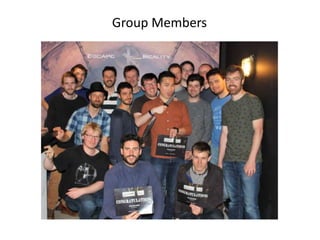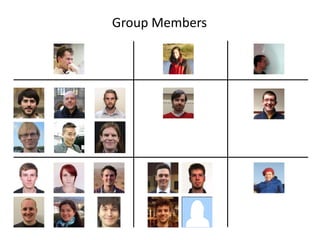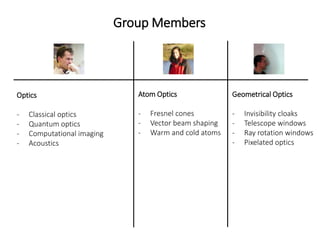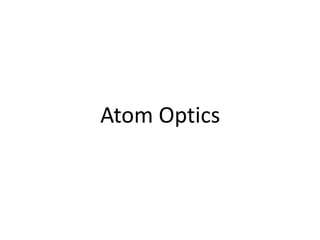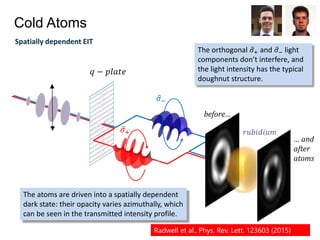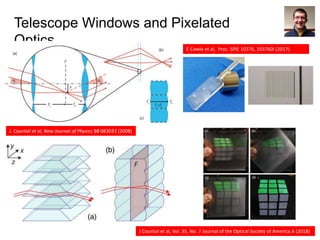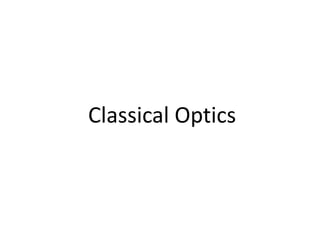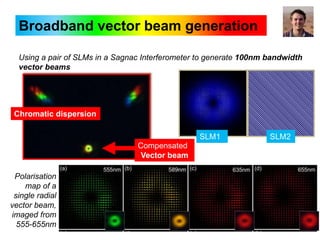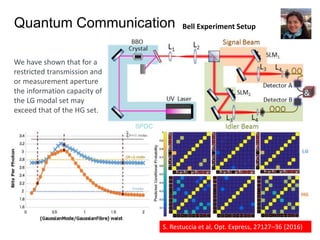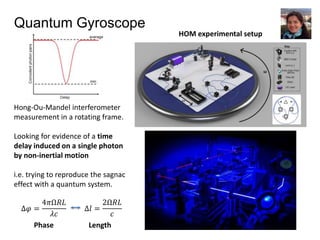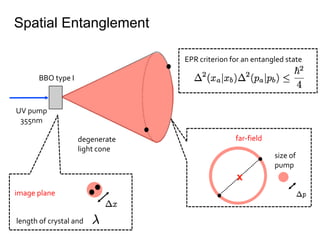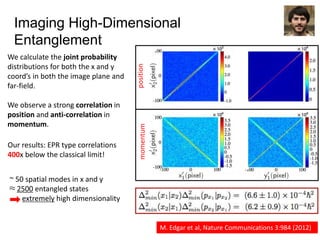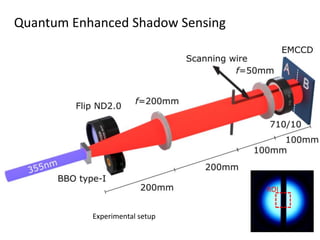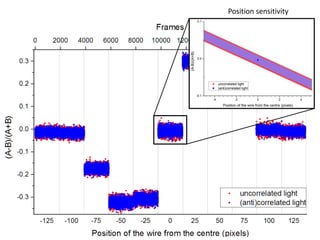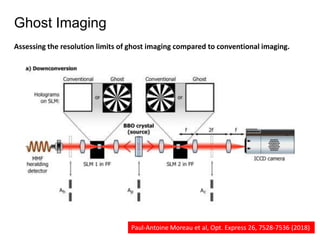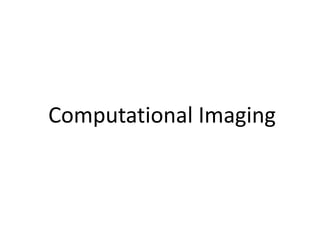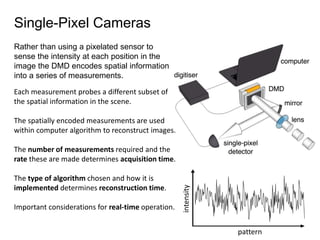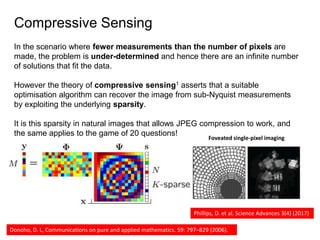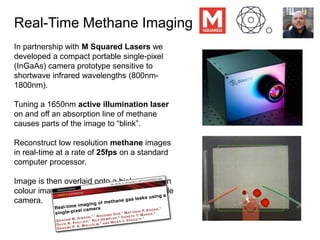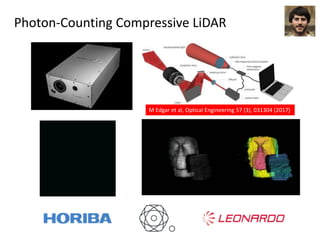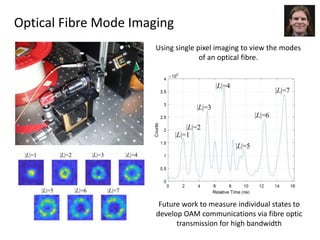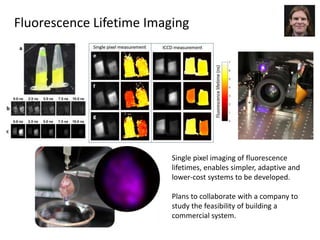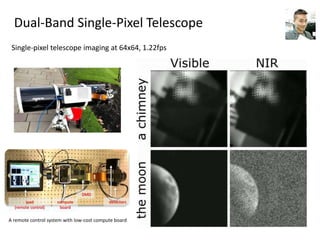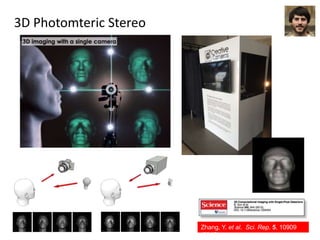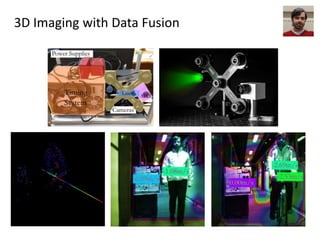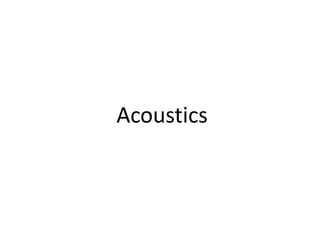Optics group research overview
- 4. Group Members Geometrical Optics - Invisibility cloaks - Telescope windows - Ray rotation windows - Pixelated optics Atom Optics - Fresnel cones - Vector beam shaping - Warm and cold atoms Optics - Classical optics - Quantum optics - Computational imaging - Acoustics
- 5. Atom Optics
- 6. Fresnel Cones λ/4 waveplate in cylindrical coordinates: Radwell et al., Nature Communications 10564 (2016) 𝜎− 𝐶𝑜𝑛𝑒 𝑒2𝑖(𝜑+𝜋/4) 𝜎− + 𝜎+ OAM of 2ℏ Polarisation vortex
- 7. Cold Atoms Spatially dependent EIT 𝜎+ 𝜎− The orthogonal 𝜎+ and 𝜎− light components don’t interfere, and the light intensity has the typical doughnut structure. The atoms are driven into a spatially dependent dark state: their opacity varies azimuthally, which can be seen in the transmitted intensity profile. Radwell et al., Phys. Rev. Lett. 123603 (2015) 𝑞 − 𝑝𝑙𝑎𝑡𝑒 𝑟𝑢𝑏𝑖𝑑𝑖𝑢𝑚 … and after atoms before…
- 9. Telescope Windows and Pixelated Optics J. Courtial et al, New Journal of Physics 10 083033 (2008) E Cowie et al, Proc. SPIE 10376, 103760I (2017) J Courtial et al, Vol. 35, No. 7 Journal of the Optical Society of America A (2018)
- 10. Classical Optics
- 11. Broadband vector beam generation Chromatic dispersion SLM2SLM1 Polarisation map of a single radial vector beam, imaged from 555-655nm Using a pair of SLMs in a Sagnac Interferometer to generate 100nm bandwidth vector beams Compensated Vector beam
- 12. Quantum Optics
- 13. Quantum Communication We have shown that for a restricted transmission and or measurement aperture the information capacity of the LG modal set may exceed that of the HG set. Bell Experiment Setup S. Restuccia et al, Opt. Express, 27127–36 (2016)
- 14. Quantum Gyroscope Hong-Ou-Mandel interferometer measurement in a rotating frame. Looking for evidence of a time delay induced on a single photon by non-inertial motion i.e. trying to reproduce the sagnac effect with a quantum system. HOM experimental setup ∆𝜑 = 4𝜋Ω𝑅𝐿 𝜆𝑐 Phase Length ∆𝑙 = 2Ω𝑅𝐿 𝑐
- 15. Spatial Entanglement UV pump 355nm BBO type I degenerate light cone far-field image plane x length of crystal and size of pump EPR criterion for an entangled state
- 16. Imaging High-Dimensional Entanglement experimental setup far-field (momentum) image plane (position) EPR identified by violating:
- 17. We calculate the joint probability distributions for both the x and y coord’s in both the image plane and far-field. We observe a strong correlation in position and anti-correlation in momentum. Our results: EPR type correlations 400x below the classical limit! ~ 50 spatial modes in x and y 2500 entangled states extremely high dimensionality positionmomentum M. Edgar et al, Nature Communications 3:984 (2012) Imaging High-Dimensional Entanglement
- 18. Experimental setup ROI Quantum Enhanced Shadow Sensing
- 19. Quantum Enhanced Shadow Sensing
- 20. 0.2 photon·frame-1·pixel-1 Quantum Enhanced Shadow Sensing
- 22. 𝜎 𝑎𝑛𝑡𝑖 𝑐𝑜𝑟𝑟𝑒𝑙𝑎𝑡𝑒𝑑 𝜎 𝑢𝑛𝑐𝑜𝑟𝑟𝑒𝑙𝑎𝑡𝑒𝑑 < Position sensitivity enhancement of 17% which was dependent on: • Width of the scanning wire • Degree of correlation, i.e. total QE Ermes Toninelli et al, Opt. Express 25, 21826-21840 (2017)
- 23. Resolution Enhanced Quantum ImagingResolution-enhanced imaging by centroid estimation of biphotons 12% resolution-enhancement (41% of maximum theoretical value)
- 24. Ghost Imaging Paul-Antoine Moreau et al, Opt. Express 26, 7528-7536 (2018) Assessing the resolution limits of ghost imaging compared to conventional imaging.
- 25. Ghost imaging ≠ to heralded imaging Large pump beam Small pump beam HeraldedimagingGhostimaging Resolution NOT DEGRADED by diameter of pump beam Resolution IS DEGRADED by diameter of pump beam Medium pump beam Ghost Imaging
- 27. Single-Pixel Cameras Rather than using a pixelated sensor to sense the intensity at each position in the image the DMD encodes spatial information into a series of measurements. pattern intensity Each measurement probes a different subset of the spatial information in the scene. The spatially encoded measurements are used within computer algorithm to reconstruct images. The number of measurements required and the rate these are made determines acquisition time. The type of algorithm chosen and how it is implemented determines reconstruction time. Important considerations for real-time operation.
- 28. Compressive Sensing In the scenario where fewer measurements than the number of pixels are made, the problem is under-determined and hence there are an infinite number of solutions that fit the data. However the theory of compressive sensing1 asserts that a suitable optimisation algorithm can recover the image from sub-Nyquist measurements by exploiting the underlying sparsity. It is this sparsity in natural images that allows JPEG compression to work, and the same applies to the game of 20 questions! Donoho, D. L, Communications on pure and applied mathematics. 59: 797–829 (2006). Foveated single-pixel imaging Phillips, D. et al. Science Advances 3(4) (2017)
- 29. • Close collaboration between computing science (Rod Murray-Smith, Catherine Higham) and physics (Matthew Edgar, Miles Padgett) has resulted in new sensing and reconstruction techniques that utilise deep-learning. • Using only 666 patterns (4% of Nyquist) yields high-quality video at 15 fps. Previous technique: evolutionary Hadamard scan using 666 patterns Deep-learning technique: deep-learned basis of 666 patterns and reconstruction Deep-Learning Real-Time Compressive Video C Higham et al, Scientific Reports 8, 2369 (2018)
- 30. Real-Time Methane Imaging In partnership with M Squared Lasers we developed a compact portable single-pixel (InGaAs) camera prototype sensitive to shortwave infrared wavelengths (800nm- 1800nm). Tuning a 1650nm active illumination laser on and off an absorption line of methane causes parts of the image to “blink”. Reconstruct low resolution methane images in real-time at a rate of 25fps on a standard computer processor. Image is then overlaid onto a high-resolution colour image acquired by a co-aligned visible camera.
- 31. Photon-Counting Compressive LiDAR M Edgar et al, Optical Engineering 57 (3), 031304 (2017)
- 32. Using single pixel imaging to view the modes of an optical fibre. Future work to measure individual states to develop OAM communications via fibre optic transmission for high bandwidth Optical Fibre Mode Imaging
- 33. Single pixel imaging of fluorescence lifetimes, enables simpler, adaptive and lower-cost systems to be developed. Plans to collaborate with a company to study the feasibility of building a commercial system. Fluorescence Lifetime Imaging
- 34. Multimode fibre output when scanning spot on input facet. Fibre output after using a measured transmission matrix. Early attempt at 3D imaging with illumination from scanning spot beyond a multimode fibre. 3D Imaging Beyond Multimode Fibres d A completely fibre-based imaging system would require collecting back-scattered light through a fibre to photodetector. A standard multimode fibre at a range of 5 metres away from an object would see only 1 in every 109 photons returning.
- 35. Dual-Band Single-Pixel Telescope A remote control system with low-cost compute board compute board ipad (remote control) DMD detectors Single-pixel telescope imaging at 64x64, 1.22fps
- 36. 3D Photomteric Stereo single-pixel photodetector object light projector object camera light source Left Right Top BottomLeft Right Top Bottom BA ˆd ˆn ˆl ˆd ˆn ˆl Zhang, Y. et al. Sci. Rep. 5, 10909 (2015).
- 37. 3D Imaging with Data Fusion
- 38. Acoustics
- 39. Reversal of Orbital Angular Momentum arising from an Extreme Doppler Shift When observer chases after the sound emitted from an ambulance siren at supersonic speeds it creates what we might call a ‘negative’ frequency. At certain velocities, the observer would hear the sound of the siren backwards instead of the familiar repetitive rise and fall, because the observer is now moving faster than the sound they are hearing – the most recent sound it makes will reach the observer ahead of those it made in the past, the opposite of how sound travels at subsonic speeds G Gibson et al, Proceedings of the National Academy of Sciences 201720776 (2018)
- 40. Outreach
- 41. Royal Society Summer Science Exhibition (2014) Cheltenham Science Festival (2018) Glasgow Science Centre ‘Making the invisible visible’ (2017) Creative Cameras Hunterian Museum (2015) Public Engageme Hunterian Museum at Glasgow Univer exhibition including regular talks on lig Quantum technologies versus zombie apocalypse (2016) AR App for Mobile Quantum Imaging Outreach (2018)
Editor's Notes
- Generates spatially varying polarisation patterns from uniform input light in a broadband manner due to total internal reflection (phase shift between the s and p polarisation components at the cone surface; the definition of s and p varies azimuthally) Output beam carries OAM Can be used to generate radial or azimuthal polarisation Can be used as a polarimeter for uniform polarisation
- Vector beams, generated from cones, DMDs/SLMs, or q-plates as shown here, in conjunction with carefully controlled magnetic fields can lead to phase-dependent absorption in cold atoms In this scenario atoms are transparent for one linear polarisation – similar to polariser, direction of which is dictated by the direction of external magnetic field: can be used to measure small magnetic field deflections Atoms also give rise to potentially massive dispersion due to Kramers-Kronig relations, leading to slow light – potential to use as a spatially dependent quantum memory
- Potential use in low vision aids for people with impaired vision. Top is two sheets of lenslets, placed confocally (i.e. a telescope). Bottom is an array of dove prisms (a) and a confocal lenslet array (b). Here (b) is the same as (c) above. Two sheets of (b), suitably placed, rotate the view. Right, is this in action with (cheapish) lenslets.
- The end goal of Kevin’s broadband beam shaper is to have arbitrary spatial control and polarisation control of either white light or ultrashort pulses of light. This is a similar goal to Neal’s achromatic vortex beam with the glass cone, except I can theoretically generate any polarisation, not just the shapes dictated by the cone shape.
- There is interest in the use of spatial optical modes for encoding both quantum and classical information. At the most fundamental level, a photon has many degrees of freedom: polarisation, frequency, position, spatial mode, etc., any of which can be used to encode information but all create additional channels. However at the quantum regime, the extent to which one can encode information simultaneously and independently in both the position and momentum variables is limited by the uncertainty principle, which applies also for angular position and angular momentum.
- A commonly used source of entanglement is a pumped beta-barium-borate (BBO) crystal. One technique to generate spatially entangled light and that was used in this experiment relies on pumping a non linear beta barium borate, or BB0, crystal with 355nm UV light. Approximately one in a billion of these photons will split into two photons at around 710 nm wavelength, due to energy conservation. In the image plane we observe correlations in the positions of the photons and in the far-field we will find anti-correlations in their measured momenta. The error in the locations of the photons in the imaging plane is defined by the length of the crystal and the wavelength of the degenerate light. The sum of the positions in the far-field will be centred around zero, with an error defined by the size of the pump beam.
- Recent years have seen a rapid advance in imaging technologies. Developments in low-noise electron multiplying CCD (EMCCD) cameras suggest they are capable of ~ 90% QE and can provide single photon sensitivity.

